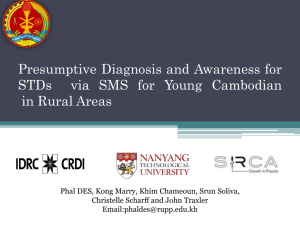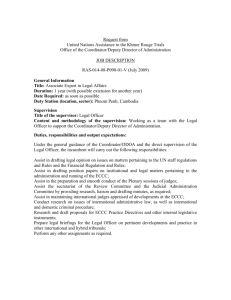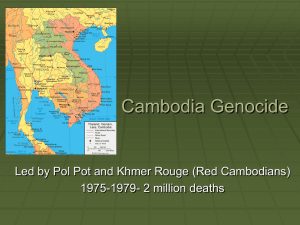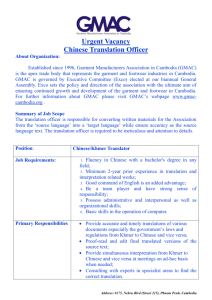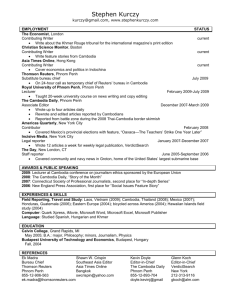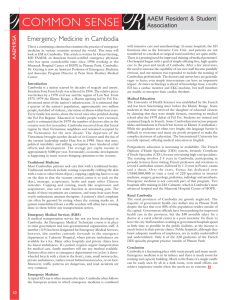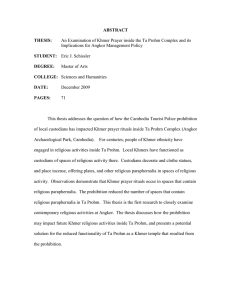Non-Profit Medicine and the Language Barrier in Cambodia August 2012
advertisement
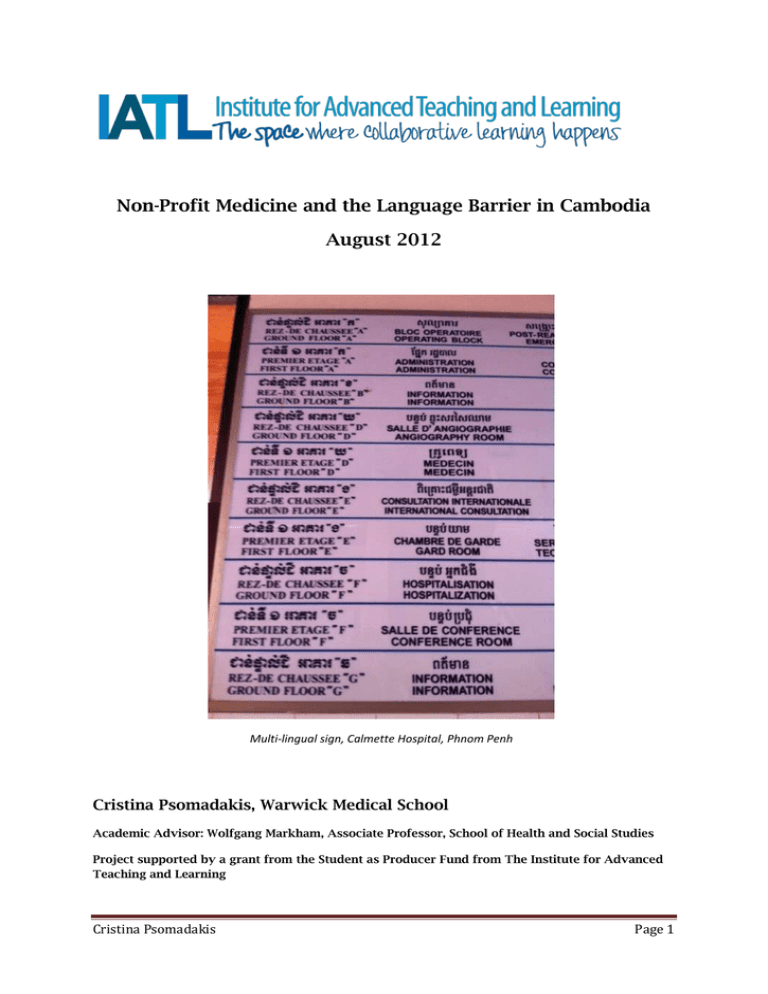
Non-Profit Medicine and the Language Barrier in Cambodia August 2012 Multi-lingual sign, Calmette Hospital, Phnom Penh Cristina Psomadakis, Warwick Medical School Academic Advisor: Wolfgang Markham, Associate Professor, School of Health and Social Studies Project supported by a grant from the Student as Producer Fund from The Institute for Advanced Teaching and Learning Cristina Psomadakis Page 1 ABSTRACT The aim of this paper is to investigate the complicated, multilingual environment of medical education and practice in Cambodia. Cambodia’s past history of colonisation and civil conflict has contributed to the construction of a medical field that communicates through Khmer, French and now English. The patients invariably speak exclusively Khmer, the doctors are educated in French, but have recently been forced into using English in order to interact with foreign aid workers, and the nurses tend to have enough knowledge of both foreign languages to be able to function professionally. Language competency and the ability to understand are therefore often divided along educational and socioeconomic lines. There is also the question of the viability of using exclusively Khmer as the language of medicine. Currently the existing vocabulary in Khmer is insufficient to satisfy the ever-advancing medical realm, however that does not mean without certain linguistic planning and education it would be impossible. However, such a transition may limit Cambodian doctors and medical students in their pursuit of specialist training abroad and their access the resources like journals and textbooks. Introduction The use of medical interpreters in a clinical context has been studied broadly, although primarily where the patient speaks the minority language. What has been studied less is a unique environment where medical staff have to negotiate multiple cultural and linguistic competencies in order to facilitate diagnosis and management, while at the same time building a relationship with the patient. Such an environment exists in Cambodia. With the assistance of an IATL grant, I decided to explore this issue in a small clinic in Phnom Penh, Cambodia, where a three-tiered translation system is employed. The official language of the country is Khmer, although medical education occurs mainly in French. Cambodian doctors and medical students write notes in French and use French medical terminology when speaking to each other. Patients, especially ones that travel from the provinces to receive medical care, rarely speak any French, which means they are at times unable to understand their doctors. Nurses and administrative staff have limited French education, although they learn on the job. Further complicating the picture, the majority of doctors at the clinic I observed were visiting Americans, so there was a revolving translation from French to Khmer to English. Data was collected over a three-week period and a series of qualitative interviews were obtained from nine Cambodians (two nurses, three doctors, two admin assistants and two medical students) and six Americans ( two doctors, one nurse, one Echo tech, one hospitalist). The goal was to assess how French is being used in a medical setting, and to examine the history of this tradition. Furthermore, it was to understand how Cambodia, which relies heavily on development assistance (Annear:2008), navigates through such a complicated multi-lingual healthcare system when interacting with foreign medical teams, as Cristina Psomadakis Page 2 well as to explore an increasing preference for English, which may change the way medical education is conducted. Finally, it is interesting to consider what place Khmer has as a language of medicine in the country, and how it is employed to communicate with patients. The French-speaking doctor Medical education and practice in Cambodia cannot be thoroughly understood without a historical context. The roots of modern day healthcare developed during French colonialism, beginning in 1863, when “the public health system was non-existent; when France left in 1955 it was rudimentary” (Martin:1994). The French played a large role in laying down the foundation of Western medicine in the country, establishing the first hospital, L’Hospital Mixte, and creating a training program for native medical attendants in 1905 (Trankell and Ovesen:2004). A history of colonisation only partially explains why French is still the language of medicine in Cambodia, however; the country’s recent history also plays a part. During the mass genocide that occurred under Pol Pot in the late 1970s, Western doctors fled the country and native staff were killed and hospitals abandoned (Noirhomme et al: 2007, Annear:1998, Hardeman:2008). Santini (2002) grimly points out that “of the 530 practising doctors in the country in the early 1970s, only 32 remained—two of whom were surgeons.” The medical education system had to be entirely reconstructed after the Khmer Rouge, and this effort was hampered by another decade of political instability. France invested heavily in the development of Université des sciences de la santé du Cambodge (Phnom Penh University of Health Sciences [UHS]) (Santini:2002), the oldest and more prestigious of the two medical schools in Phnom Penh. Unsurprisingly, the majority of teaching there is conducted in French. One medical student at the clinic I observed explained the logistics behind language choices in the classroom: “The textbook and PowerPoint lessons are all in French, but the teacher will use Khmer. Even then the medical terminology will be French.” For a medical student in Cambodia, learning French not only means accessing educational resources, but also securing a training post in France to specialise. One of the medical students said: “We used to have a translation of every medical word into Khmer but we found it very difficult, and even if we used it with the patients they still didn’t understand. So we tend to use all the medical words in French. It also benefits the medical students because after we graduate we can go to France to do specialty training.” French forms one of the crucial tiers of the multilingualism present in Cambodian medicine, but consequently creates a language barrier between local doctors who know the language and the patients who do not. Cristina Psomadakis Page 3 The Khmer-speaking patient Cambodia is a country with a low literacy rate (26% according to Zimmer: 2008) and many rural inhabitants have limited formal education. It is extremely rare that the patients are familiar with the French terminology being used to discuss their conditions, so doctors have to rely on Khmer to explain it to them. “There are simple terms in Khmer that we can use for the patients. So for kidney, there is both the medical word no one uses and a more simple term. So ‘domrong dom’ means kidney but it is not really a medical term. The same thing happens in English: you have both the word ‘kidney’ and ‘renal,’” one medical student pointed out. Another medical student suggested that this means a lot of time is spent in the consultation trying to explain concepts to patients, although this didn’t sound too dissimilar to English medical language. The crucial difference in English, however, is that the patient is exposed to a term, which is then explained. The problem with relying on doctors’ explanations without any standardised terms is that patients may have the same diagnosis explained differently. One of the clinic neurologists said: “We don’t use the proper word because we don’t have the clinical word. It makes it very hard to explain to the patient in Khmer, because we have to translate and sometimes we don’t use the right words. They become confused because one doctor explains one way and another a different way, but they often mean the same thing.” The multilingual medical staff Apart from communication with the patient, another key to delivering quality healthcare is the ability to communicate with the wider medical team. For Cambodians this includes healthcare and administrative assistants, visiting foreign doctors who mainly speak English, and medical graduates from the International University, the newer of the two medical schools, where education is conducted in English. The majority of nursing training occurs in Khmer, but depending on the training facility, some nurses will learn basic terminology in French and/or English. The nurses interviewed said their French was very limited and that all the notes they wrote were in Khmer. One of the supervising nurses, responsible for training, felt quite strongly that medical multilingualism can be problematic: “I think any country that uses different languages in a single context is setting themselves up for failure. You can’t have two, three or four different languages together and not expect that to cause some kind of impact.” In the past decade, a language barrier not only exists between doctors and nurses, but has emerged among doctors themselves. In 2002 the International University opened, Phnom Penh’s second medical school, where teaching is conducted entirely in English. The IU graduates don’t have any French training, but often have to work together with Frenchspeaking University of Health Sciences graduates. The UHS student said this limits where IU doctors can work: “Most of the public hospitals right now don’t allow the IU students to train Cristina Psomadakis Page 4 there because those hospitals use French. It is hard to communicate with them. If we were to work together I think we would explain most things in English.” Although French has been the dominant language among medical professionals in Cambodia, it is has been essential to speak English. There are many foreign aid and medical workers that come into Cambodia and depend on English as their means of communication. In the clinic featured in this study, a group of American health professionals came throughout the year to offer free medical services. The American medical staff largely reported that they were able to interpret the French patient notes on most occasions. One of the visiting cardiologists said “I am getting pretty good at reading French. We have translators who can read French and explain it to me so I don’t think there is a great deal of misinterpretation of the data, especially since we have medical students and we now have Cambodian physicians who are on our team who can communicate.” The future of medical multilinguism The launch of IU’s medical program in English, coupled with depleting resources coming in from France and fewer training positions available for Cambodian students, indicate an increasing importance on English as the new language of medicine. One medical student said: “Right now many foreign doctors that visit, many books and journals and especially the internet, it is all in English. Also, the amount of places open to Khmer medical students going to France is less than before, so you will have more opportunities to go somewhere English speaking. Some specialties, like ophthalmology, are now English only.” The IU student, whose school is considered less prestigious and currently offers less training opportunities, believes that her university will increase in status because it is ahead of the curve: “I think I will have more opportunities than someone who speaks French in the future, because more countries speak English. In other fields in Cambodia they already use English, so French is a little bit out of date. People are trying to use English more.” As a transition from French to English is underway in Cambodian medical practice, one has to wonder if there is a place for developing Khmer to suit the field. But it is hard to advocate for an exclusively Khmer-based medical education, and the popularisation of Khmer medical terminology, when students and doctors are so reliant on training opportunities abroad, foreign educational materials and international aid workers. Conclusion This paper has attempted to present the complex multilingual environment of medicine in Cambodia. A past history of French colonisation introduced the concept of Western medicine, and created a prototype of medical education in the country. As a result, there is a strong precedent for using French medical terminology. Cristina Psomadakis Page 5 However, after the Khmer Rouge abolished modern medicine in the name of creating an agrarian society, there was an opportunity to reconstruct medical infrastructure, and therefore re-envision the language of medicine. This effort was coordinated with foreign aid at the helm, where the interests of the Khmer people came secondary to the interests of the investors. This has meant that Cambodian doctors speak French, whereas the nurses speak English, and medical students are instructed in one or the other depending on which medical school they attend. Foreign medical aid workers in Cambodia have to rely on interpreters, or familiarise themselves with both French and English terminology when they read patient notes or prescriptions. As the landscape of medicine in Cambodia continues to change, and English is given a more prominent role, one wonders for the future of Khmer in the field. But Cambodians have just put behind them a recent history of conflict and bloodshed, and as they begin to participate in the international scene they want the same opportunities and access as their Southeast Asian neighbours, and knowing English helps to provide that. Whatever the solution, it seems like some linguistic consistency among medical healthcare staff, as well in creating diagnostic labels for patients, would facilitate communication and help propel the field REFERENCES 1. Annear, P. 1998. Health and Development in Cambodia. Asian Studies Review, 22: 193–221. 2. Hardeman W., Van Damme W., Van Pelt M., Por I., Kimvan H., and Meessen B. 1994. Access to Health Care for all? User Fees Plus a Health Equity Fund in Sotnikum, Cambodia. Health Policy & Planning, 19(1): 22-32. 3. Martin, M. Cambodia: A Shattered Society, (revised English edition). Los Angeles: University of California Press. 4. Noirhomme M., Meessen B., Griffiths F., Ir P., Jacobs B., Thor R., Criel B., and Van Damme W. 2007. Improving Access to Hospital Care for the Poor: Comparative Analysis of Four Health Equity Funds in Cambodia. Health Policy Plan, 22(4): 246262. 5. Santini, H. 2002. Rebirth of the Health-Care System in Cambodia. The Lancet, 360: 57-58. 6. Trankell, I and Ovesen, J. 2004. French Colonial Medicine in Cambodia: Reflections of Governmentality. Anthropology & Medicine, 11:1, 91-105. 7. Zimmer Z. 2008. Poverty, Wealth Inequality and Health Among Older Adults in Rural Cambodia. Soc Sci Med, 66(1):57–71. Cristina Psomadakis Page 6
![Cambodian New Year - Rotha Chao [[.efolio.]]](http://s2.studylib.net/store/data/005298862_1-07ad9f61287c09b0b20401422ff2087a-300x300.png)
